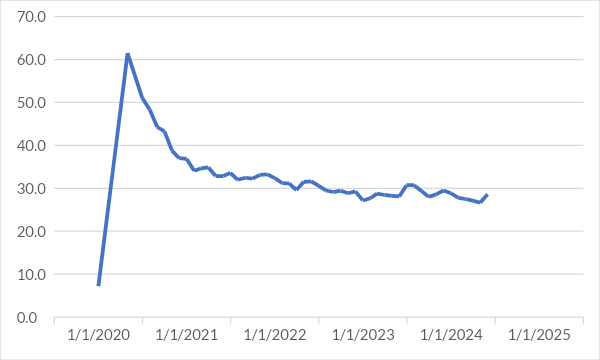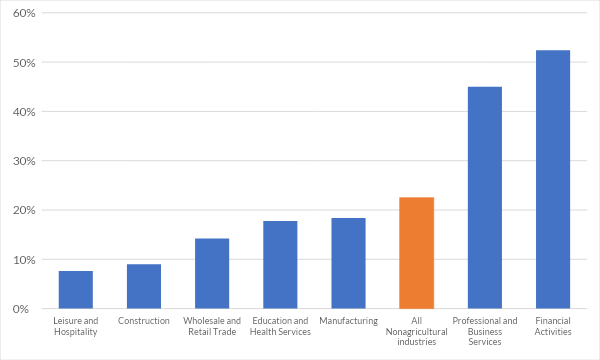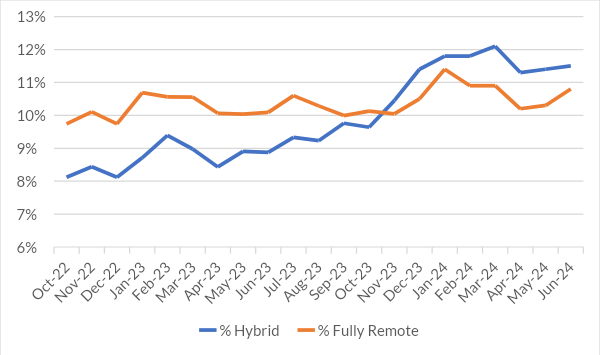
As highlighted in our recent Best Performing Cities report, remote work remains the norm for many US workers almost four years after the onset of the COVID-19 pandemic (Figure 1). In early 2020, the possibility of working remotely transformed the make-up of our urban workforce, leading to high and sustained office vacancy rates and a general hollowing-out of many city centers, as reported by CNN. With varying trends in remote work by region and industry, further insight into how remote work is solidifying itself in a post-pandemic economy is necessary to understand the performance of many US cities.
Figure 1. Percent of Days Working Remotely since March 2020

Source: Milken Institute analysis using data from WFHResearch (2024). See also Barrero, Jose Maria, Nicholas Bloom, and Steven J. Davis, 2021, "Why Working from Home Will Stick," National Bureau of Economic Research Working Paper 28731.
Until 2020, the share of work done remotely hovered at around 6 to 7 percent, according to data from WFH Research. Following stay-at-home mandates, the proportion of remote work jumped up rapidly, with about 61.5 percent of work done at home in May 2020. As return-to-office became a priority for many employers during 2021 and 2022, the proportion of days when employees worked from home decreased but remained at about 28.6 percent in June 2024. This suggests that, despite a significant return-to-office push by employers in 2021 and 2022, fully or partially remote work is a feature, not a bug, of the post-pandemic economy.
According to a recent measure produced by the Bureau of Labor Statistics (BLS) that shows the number of workers reporting remote, hybrid, and fully in-person workdays, fully remote work has remained steady since 2022, while hybrid work has risen steadily, with the percentage of hybrid workers surpassing the percentage of fully remate workers since December 2023 (Figure 2).
Figure 2. Fully Remote and Hybrid Work Trends through 2023

Source: Bureau of Labor Statistics Current Population Survey, Milken Institute analysis (2024)
Looking ahead, with the recent rise in hybrid work, location flexibility should continue to be an attractive feature of new job postings.
Regional and Industry Sector Differences in Remote Working
The rate of remote work differs across industries and sectors (Figure 3). While teleworking among all industries in June 2024 covered over 20 percent of workers, occupations such as leisure and hospitality and construction had only 8 to 9 percent of fully remote or hybrid workers. In contrast, financial services (the sector with the highest proportion of work done remotely) had over half of all employees working either fully or partially remotely in June 2024.
Figure 3. Remote Workers Make up Over Half of the Financial Activities Sector


Note: Limited to the top five super-sectors, as defined by the BLS.
Source: BLS Current Population Survey, Milken Institute analysis (2024)
As a result of this teleworking sectoral divide, tech hubs such as Austin and San Francisco are impacted by remote work differently than cities that rely primarily on industries like leisure and hospitality or education and health services.
For Austin in particular, Stanford University researchers have observed a “donut effect” caused by remote work, where city centers are hollowed out in favor of the surrounding areas. While the population in the entire Austin metropolitan increased by about 8 percent from 2019 to 2023, most of this growth occurred outside of the county that contains the city of Austin, as reported in Axios. Reflecting this trend, Austin saw around a drop in its remote share in 2022, while parts of Hays County, a more rural area between Austin and San Antonio, experienced an increase in their share of remote workers, according to the Economic Innovation Group.
The trend is also related to the observable exodus from large cities since the pandemic, accelerated by location flexibility and high cost of living. According to The Hill, between April 2020 and July 2022, 17 of the 25 largest counties in the country saw population losses. Recently, however, many big-tech giants, including Amazon, Alphabet, and Meta, have begun backtracking on fully remote work in favor of a hybrid schedule that requires in-office presence two to three days a week, Technology Magazine reports. These changes have helped revitalize high-tech rich cities such as San Francisco, according to The San Francisco Standard. As employers evaluate the effectiveness of different working environments, work conditions continue to shift, even as fully in-office work may no longer be a reality for many US workers.









